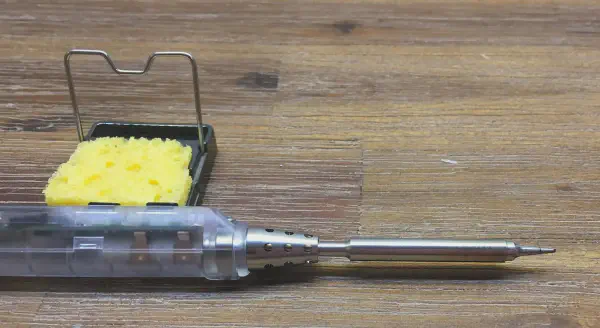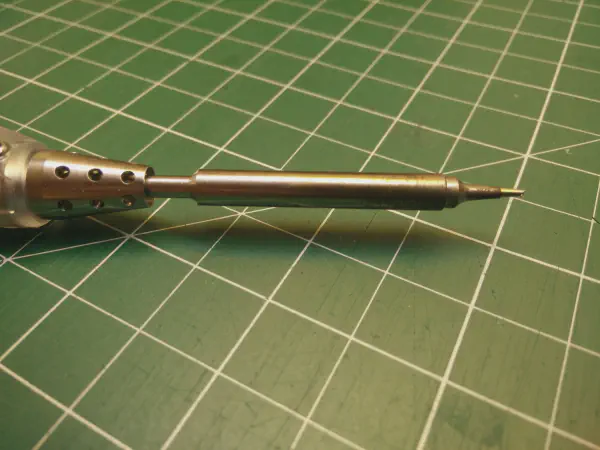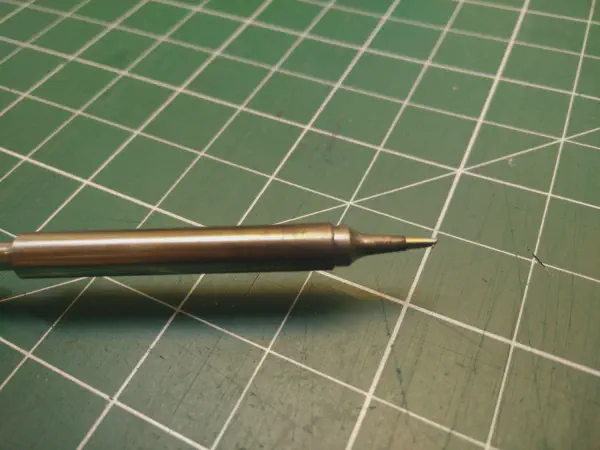Review
The TS100 is possibly the best soldering iron I have used for under $200. It is very lightweight and portable, runs off a wide range of power sources and has full PID temperature control built in. The built in accelerometer provides a protective sleep mode to prolong the length of your tip. With the 65W power rating, it heats to 360 Celsius in under 8 Seconds.
Main Features
- 65W rated output (24V Input).
- Interchangeable Tips (<$10 Each).
- Accelerometer puts the unit to sleep automatically
- Runs excellently off LiPo Batteries in the field (Drill or Quadcopter or Car Battery).
- Also runs off most Laptop power supplies that you have around.
- Solid construction, fairly tolerant of being thrown in a field bag.
- Open Source Firmware allows feature additions.
TS100 by Miniware firmware
Over seven months ago I wrote about the new to me TS100 soldering iron, which I started a fork of the firmware for. Over this period both the firmware, I initially wrote to provide a menu system for configuration has evolved to provide more and more features at the request of users. Miniware have now released the 2017 update to their offical firmware which adds a nice menu system to the iron as well! So both are worth checking out.
I have been actively maintaining and improving this firmware, mostly because I use the iron daily at my bench (it has replaced my nice Weller WES51D completely). Running the unit at 12V it feels sluggish but works well for in the field patches and repairs to existing cabling. When the iron runs at higher voltages (especially 20V / 5S) it becomes an incredibly powerful iron, especially for large connectors such as the XT90 plugs that are found in hexacopters and larger builds.
I originally started my fork of the firmware for the unit, purely to add a settings menu that can be used on the device without USB. As USB is not always available, and I wanted to be able to adjust the cutoff voltage setting when I changed batteries in the field. I’m continuing the firmware development, as a means to further push the performance of the iron, and also to improve the features that are available to end users.
Over the past months, I have been honestly stunned with the iron, in so much as to say it exceeded every expectation I had, and I never knew how nice the sleep mode was. The only issues I encountered were my own fault, my original tip is bent and my casing cracked around the tip entry to the iron. These both occurred when the iron was kept in my backpack during a holiday and I didn’t have the tool to remove the tip from inside the Iron.
Up and coming
I was contacted by Miniware, the designers of the TS100, as they had seen my alternate firmware. They are supportive of the firmware and have even updated their official firmware to integrate a menu system. This provides users with a choice of two firmware, which I like as it keeps the pressure up to innovate on the possible features in the software. They contacted me and provided me with a sample of a new tip they are planning to release, along with a sample of the small (tiny, tiny) stand for the iron. They also provided a clear shell case, which looks fantastic (though not sure how it will go through customs).
They have now announced an official XT60 adapter cable for powering the iron. I really appreciate this development, as I have made up quite a few of these cables for both myself and friends. (And theirs is much nicer quality, with fully moulded ends).
Future Tip

New Tip Design
I was sent a pre-production run prototype of the new tip design that they are releasing. This is a model TS-C1 tip, which is a small sized tip, with a 45-degree angle on it. I am using this tip now in the place of my old one, and so far it has been a nice improvement. The small perforated metal section at the base provides a nice holding spot for close up work but does get warm eventually. Even when warm it does provide a nicer shape to the iron and protects the weaker narrow point (which is where my original tip bent).
As this tip has a much finer point, it is more suited to smaller SMD style components, and the angle on the tip works well for drag soldering and cleaning up QFN style components. I have soldered a few XT60 connectors with this finer tip, it is definitely slower than the original tip, however, it did eventually work. This tip is a pre-production tip and they did warn me the temperature control may not be perfect (it’s close according to my thermocouple though). So while this does not indicate the performance of the production run tips, it certainly looks good.
After hand assembling three boards covered 0603 and 0402 components, the tip is definitely nicer than the Weller for fine pitch work.
The tiny, tiny stand

The C1 Tip
The small soldering stand folds up for transport, and the clip does sort of hold the sponge in. I have currently stored it in the little plastic box it came in to prevent losing the sponge. It is really small (around 3.5x4cm), but the iron rests on it well, and the sponge is a really good fit (just slightly snug when wet). It does include a spare sponge, so I have stored that one away for when I lose this one ( which I know I will).
Clear case
These are available through some sellers now, which is really nice. The clear case was chosen as it looks much cooler, and my previous one had cracked fairly badly. Though the other colours are really nice too, clear just looks nerdy.

Looking Good

